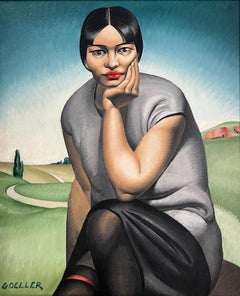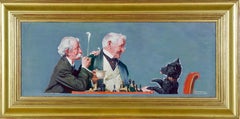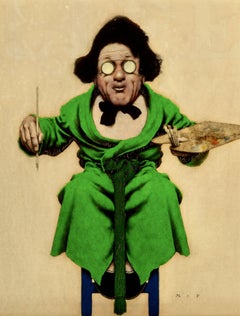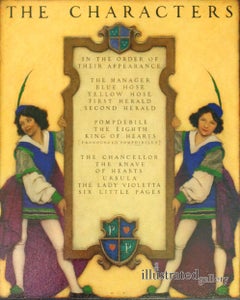Signed by Artist Lower Right
Maxwell House Coffee Illustration
Few artists have ever pulled on our nation's heartstrings, particularly in reference to family and generations, as adeptly as Norman Rockwell. From his earliest advertisements to his patriotic World War II subjects, Rockwell's virtuoso was in his ability to capture the essence of American culture and a view of a more innocent time in our country's history. Rockwell states: "I was showing the America I knew and observed to others who might not have noticed. And perhaps, therefore, this is one function of the illustrator. He can show what has become so familiar that it is no longer noticed. The illustrator thus becomes a chronicler of his time." (as quoted in Norman Rockwell: A Definitive Catalogue, Stockbridge, Massachusetts, 1986, p. xii)
Recognizing the need for reminiscence from young and old alike, Rockwell effectively captures a timeless scene: Here, two old friends gingerly and jovially play a game of chess, sipping coffee as they wait for their furry friend to make the next move. The work is executed in Rockwell's signature descriptive style of finely drawn, clear realism with a wealth of fascinating detail. In discussing his career, Rockwell commented, "I was showing the America I knew and observed to others who might not have noticed. And perhaps, therefore, this is one function of the illustrator. He can show what has become so familiar that it is no longer noticed. The illustrator thus becomes a chronicler of his time." (as quoted in Norman Rockwell: A Definitive Catalogue, Stockbridge, Massachusetts, 1986, p. xii)
Rockwell seemingly utilizes one of his favorite models in the present work-James K. Van Brunt. The artist recalled his initial meeting with Van Brunt in 1924 in New Rochelle, New York: "I remember it was June and it was terribly hot. I was working in my underwear and not getting along too well because my brushes were slippery with perspiration. Suddenly the downstairs door banged and I heard someone come up the stairs treading on each step with a loud, deliberate thump...A tiny old man with a knobby nose, an immense, drooping mustache, and round, heavy-lidded eyes stamped bellicosely into the studio. 'James K. Van Brunt, sir,' he said, saluting me and bowing all at once. 'Five feet two inches tall, sir. The exact height of Napoleon Bonaparte!' And he pushed out his thin little chest, which was encased in a fawn colored vest. 'I have fought the Confederate Army at Antietam, Fredericksburg, and in the Wilderness,' he said. 'I have battled the nations of the Sioux under Dull Knife, Crazy Horse and Sitting Bull. I have fought the Spaniards, sir, in Cuba.' And he rapped his cane on the floor and looked at me very belligerently. Then, having ascertained that I wasn't going to contradict him, he took off his gloves and his wide brimmed hat, laid them on a chair, and patted his mustache. 'This mustache, sir,' he said, 'is eight full inches wide from tip to tip. The ladies, sir, make much of it.' And he winked at me and walked over to my mirror to stare at his mustache." (My Adventures as an Illustrator, New York, 1994, p. 206)
Van Brunt was a consummate professional as a model, carefully practicing his poses in the mirror in advance of a session and, at times, inspiring the idea for the cover illustration. Rockwell stated that he used to suggest a cover almost every time they saw one another and referred to the day when Van Brunt first showed up at his studio as "one of the luckiest days of my life." (My Adventures as an Illustrator, p. 206)
James K. Van Brunt appeared in ten Post covers by Rockwell, as well as countless other paintings used as advertisements, such as the present work. Given Van Brunt's distinctive visage with his mustache, the editor at the Post, George Horace Lorimer, complained. "Rockwell recalled, 'Mr. Lorimer said to me, 'I think you're using that man too much. Everybody's beginning to notice it. Maybe you'd better stop for a while. That mustache of his is too identifiable.' Rockwell informed Van Brunt of the problem, 'If you take off your mustache I can use you again...Otherwise I just can't.' Two weeks
later Van...




